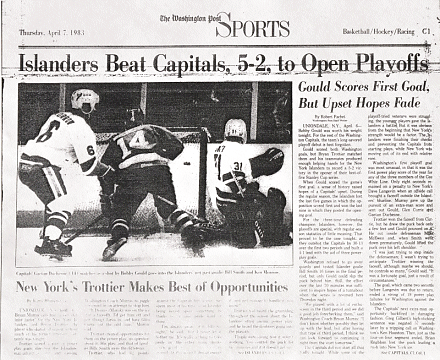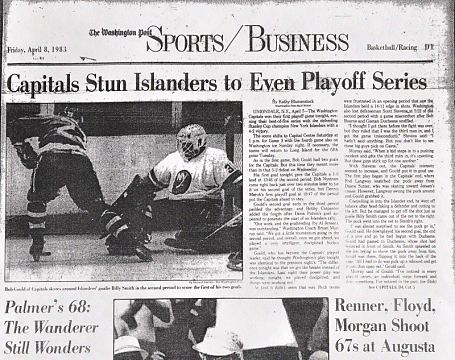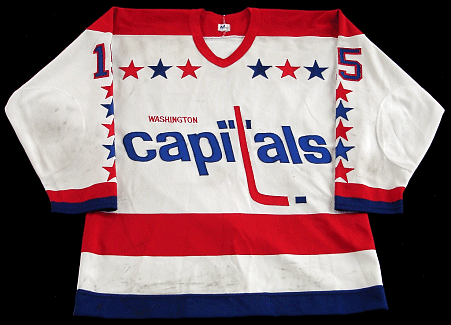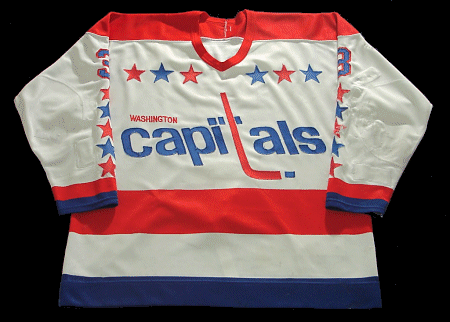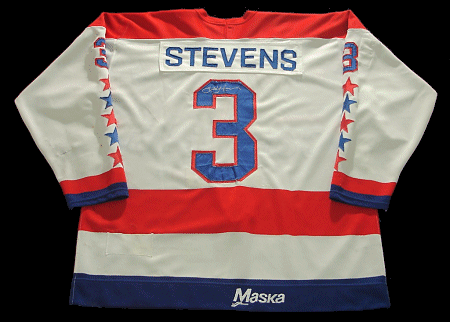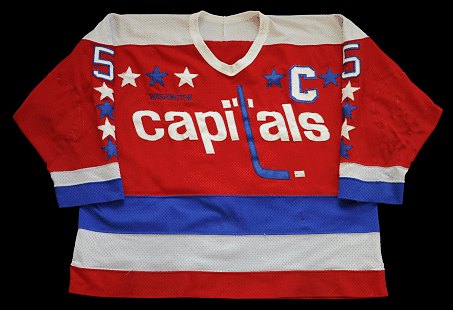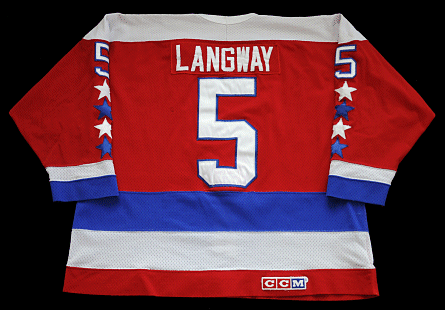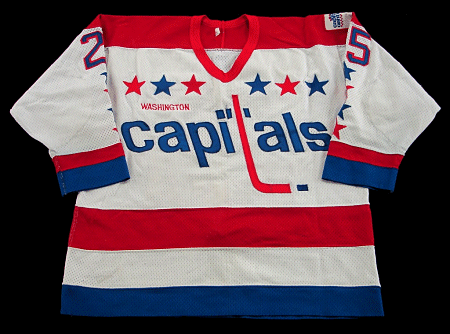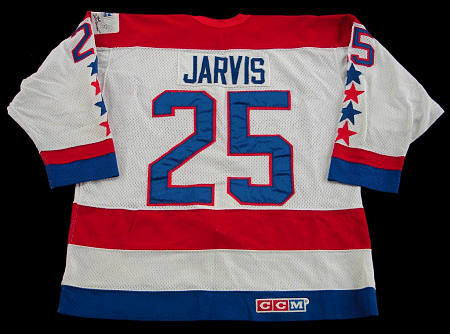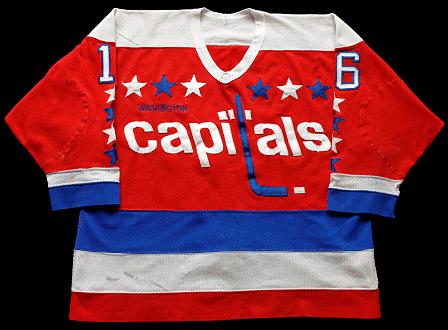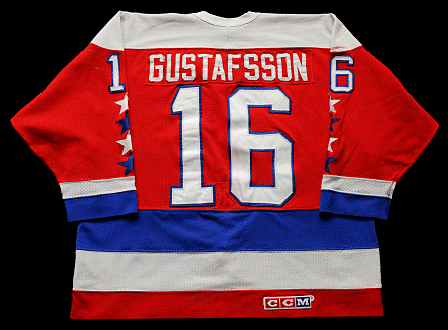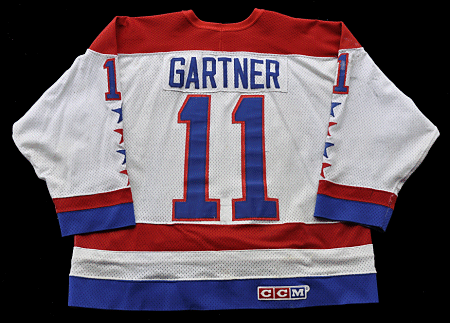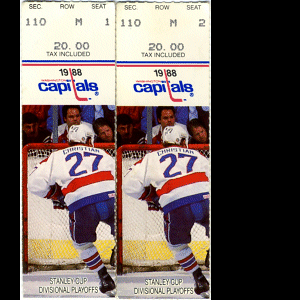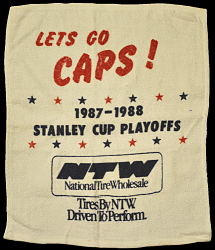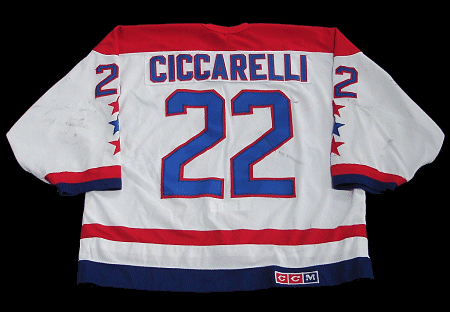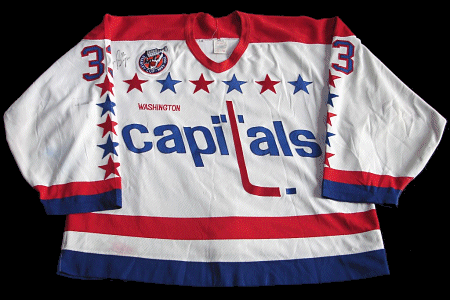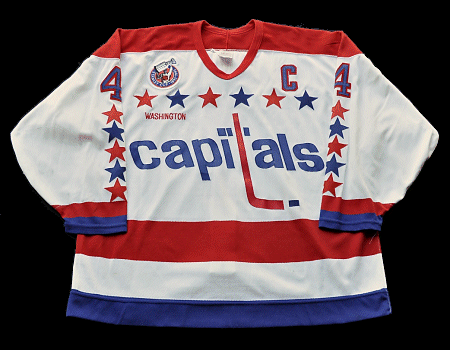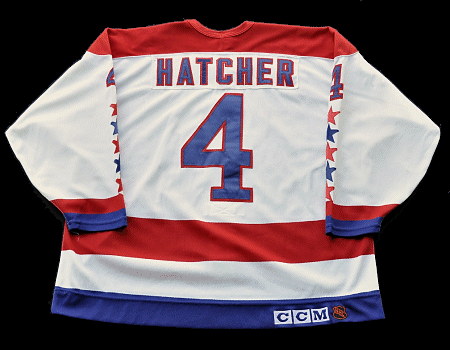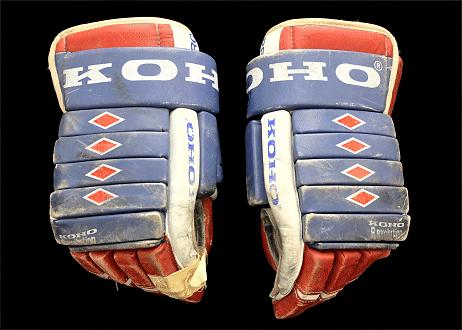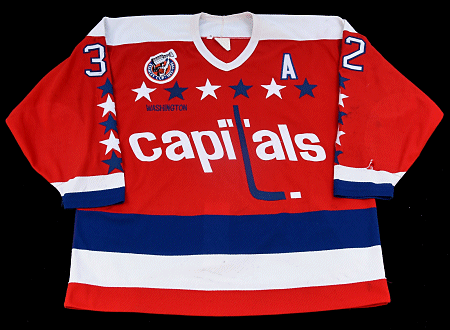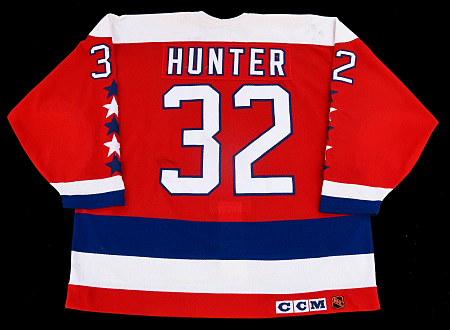The Trade
David Poile was hired as the Capitals' General Manager just
37 days before the start of the 1982-83 season and on only his tenth day as GM,
he put his mark on the team with one of the biggest trades in franchise history.
His intent was to improve the team's defense which has allowed 4.2 goals per page
the prior season. He traded the team's captain (Ryan Walter) and their best
defenseman (Rick Green), but he added two of the best defensive defensemen in the
game, Rod Langway and Brian Engblom. Also included in the trade was Doug Jarvis, an
unheralded defensive forward and a rookie named Craig Laughlin.
The trade by itself didn't make the Capitals an immediate winner - they only won
three of their first 12 games in the 1982-83 season. But when you combine it with the
hiring of Bryan Murray the prior season and the drafting of Scott Stevens, it was
the key piece that made all of the others fall into place. Murray wanted two things
from his players - be responsible defensively and don't make anything easy for
the other team. You couldn't ask for better examples of this coaching philosophy
than Langway and Engblom. They changed the mindset of the team and by Christmas,
the Capitals were playing the best hockey Washington had ever seen from its home
team. In December, the Caps put together a 14-game unbeaten streak and finished
with the first winning season in their nine year history. It had taken nine seasons,
but the Capitals fans would finally get to see playoff hockey at the Capital Centre.
Playoffs!
The Capitals finished third in the Patrick Division and would face the three-time defending Stanley Cup champion New York Islanders. Just like the regular season, the Capitals had a rough start to the playoffs. Even though Bob Gould scored the first goal of game 1, the Islanders would outshoot the Caps 30-13 in the first two periods and score three power play goals to take a 4-1 lead going into the third. Gould scored again early in the third and the Caps played tough, keeping the puck in the Islanders end for most of the third. However, they couldn't get the puck past Billy Smith and the Caps were not able to sustain a comeback, losing 5-2.
Game two was pretty even throughout, except this time the breaks went the Capitals way. Both teams had their chances in the first period, but neither team was able to score. Then in the second period Bob Nystrom tried to start a fight with Gaetan Duchesne. Scott Stevens stepped in to protect his teammate, but the referee said Stevens was the third man in and he was ejected from the game. From the Capitals point of view, this was a terrible call as Nystrom and Duchesne were just pushing and there were no fighting majors called. It certainly fired up the Caps, who played some of their best hockey of the season over the next 20 minutes. Gould would score two more goals in that time and Dennis Maruk added another to give the Caps a 3-1 lead with 10 minutes left to play. The Islanders tried to mount a comeback on a Denis Potvin goal at 14:29, but the Caps would extend the lead again on a Bobby Carpenter goal just 1:39 later and held on in the final minutes for a 4-2 win.
The Capitals returned home to play their first home playoff game on April 9, 1983. It was their third game in four days and the more experienced Islanders showed why they were on their way to a fourth straight Stanley Cup. The Capitals never had a chance giving up two goals to Bob Bourne in the first period and two more to Bryan Trottier in the second. They would go on to lose 6-2.
Game 4 was not much different, but the Capitals did manage to make it close midway through the third. Ken Houston scored to make it 4-3 with about 8 minutes to play, but it was not to be as the Islanders overpowered the Caps with two more goals in the final minutes.
Scott Stevens - Rookie Sensation
"One of the CAPS' big success stories of a year ago was the
brilliant play from their 18-year-old rookie defenseman SCOTT STEVENS... The CAPS'
first round draft pick in 1982 not only displayed the savvy of a seasoned veteran
but his aggressive and spirited play made him one of the most feared blueliners in
the league." - Washington Capitals Yearbook 1983/84
Stevens led all rookies in penalty minutes that season with 195. He finished third
in the Calder trophy voting and was named to the NHL all-rookie team. The jersey
shown above was worn by Scott Stevens during his rookie season of 1982-83. He had
his first NHL fight in this jersey on October 9, 1982 against Lindsay Carson of
the Flyers. The jersey shows the effects of Stevens's rough play with well over 100
team-sewn repairs - many of which are large patches to cover multiple rips and holes.
1983-84 season
The 1983-84 Washington Capitals may not have made it to the Stanley Cup finals or had 50 wins, but they are still one of the greatest teams that Washington has ever put on the ice because they were first. They were the first Capitals team to win 40 games (48), and the first to eclipse the 100-point mark (101). They were also the first Capitals team to win a playoff series, sweeping the Flyers in three straight. They lost in the second round to the 4-time Cup champion New York Islanders, but for the first time, after many years of futility, the Washington Capitals were a real contender for the Stanley Cup.
They cleaned up at the NHL awards, winning the Norris trophy (Rod Langway), the Selke Trophy (Doug Jarvis), the Jack Adams Trophy (Bryan Murray), and the Jennings Trophy (Pat Riggin and Al Jensen). David Poile was named "Executive-of-the-Year" by the Sporting News and Rod Langway was voted a 1st team All-Star. Pat Riggin led the NHL in Goals Against Average and the team finished first in the league in penalty killing.
The 1983-84 home jerseys are also very memorable. It was the 10th season for the team and the 10th Anniversary of the Capital Centre. They wore a patch on the left sleeve to commemorate the anniversary. These jerseys are extremely rare as the patches were only worn on one set of home white jerseys.
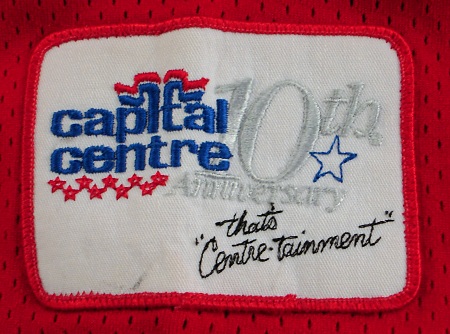
Gus scores 5!
On January 8, 1984, Bengt Gustafsson became the first player in
Capitals history to score five goals in a game (only Peter Bondra has been able to match
him since). It was a 7-1 win over the Flyers in Philadelphia and all five goals were
scored against fellow Swede Pelle Lindbergh. The five goals were scored this way.
1st / 6:19 - Gus scores on a rebound off a Timo Blomqvist shot.
1st / 11:15 - Gus receives a pass from Mike Gartner from behind the net and puts a backhand past Lindbergh.
2nd / 11:41 - Gus puts in a rebound off his own shot on the power play.
3rd / 5:12 - Gus puts in an easy one on a two-on-none break with Gartner feeding him the pass.
3rd / 10:11 - Gus stole a pass at center ice, which turned into a two-on-one with Rod Langway.
As Gus tried to make a pass over to Langway, Doug Crossman got in the way and the puck came
right back to him and he quickly poked it into the net.
The Goal Dust Twins
As Mike Gartner and Bobby Carpenter were piling up goals during the 1984-85 season, they were given the nickname, "Goal Dust Twins", in reference to an advertising campaign and radio show called the "Gold Dust Twins" from the early 1900s. Carpenter started the season hot with 14 goals in his first 17 games and continued to stay hot (and consistent) throughout the season. On January 17th, he scored his 33rd goal, passing his previous high of 32. He then set the record for most goals by an American born player on February 13th with his 42nd goal. His 50th came in a 3-2 loss at Montreal against goaltender Steve Penney. He finished the season with 53 goals, which ranks as the 4th highest total in franchise history.
Mike Gartner's season started out a little slower, with 13 goals at the end of November. He began to heat up with nine goals in both December and January and then he had 10 in February. Going into the last game of the season, he had 48 goals and 98 points. Was it going to be a near miss or a milestone season? The game was at home against the Penguins, who the Caps had beat on the road, 7-4, the night before. Surely the Penguins would play a better defensive game the second time around, right? Nope. The Caps scored 7 more, this time winning 7-3. Gartner had two goals and two assists to finish the season with 102 points and exactly 50 goals. The 50th goal came at 14:05 of the second period. Gustafsson threaded a pass to the slot and Gartner got his stick on it, knocking it passed the goalie.
Dale Hunter's Overtime Goal
"Murphy starts the rush. He hits Hunter. He's in alone... a shot... and a GOAL!" - That was the call by HTS play-by-play announcer Mike Fornes on April 16, 1988 as Dale Hunter split the defense and beat Ron Hextall in overtime of game 7 of the Patrick Division semifinals. But it wasn't just that it was a game 7 OT goal that made it so special. It was what led up to the goal.

- Three Years Before (1985): The Caps take a 2-0 series lead
against the Islanders in the first round (best of 5). Then, they lose three straight.
- Two Years Before: The Caps advance to the second round of the playoffs to face the
New York Rangers, who finished with 29 points fewer than the Capitals. They build a
2-1 series lead only to lose three straight.
- One Year Before: The Caps had a commanding 3-1 series lead on their playoff nemesis,
the New York Islanders, and they lost three in a row including a four overtime
game 7. Shortly after that game, GM David Poile trades for Dale Hunter, specifically
for his post-season heroics.
- One Week Before: The Caps are up 4-1 in game 4 with a chance to even the series
at two games each, but end up losing in overtime. Now, down three games to one in
the series, everyone writes them off. Then, they win games 5 and 6 and come back
home for game 7.
- Two Hours Before: The Caps are down 3-0 just five minutes into the second period
of Game 7. Even playoff veteran and team captain Rod Langway thought they were
done. "When it was 3-0, I thought we’d be blown out of the rink." he told the
Washington Post. But they stuck with it and Hunter racked up a goal and an assist
in the comeback and it was tied at the end of regulation.
Then, in overtime, on a breakaway, the goal was scored. It single-handedly wiped
away all of the heartache and failures that came before it and finally gave Capitals
fans something of their own. Something much more than even a game 7 overtime goal.
Patrick Division Champions
For five straight seasons from 1983-84 through 1987-88, the Capitals finished second in the Patrick Division. On the morning of March 7, 1989, the Capitals (74 pts) found themselves in a tight race with both the Rangers (76 pts) and Penguins (73 pts). Later that day, they would trade away their all-time leader in goals and points (Mike Gartner), their top offensive defenseman (Larry Murphy), and their starting goaltender (Clint Malarchuk). In return, they received Dino Ciccarelli, Bob Rouse, and Calle Johansson. Bob Rouse was almost the anti-Larry Murphy - a tough, steady, defensive defenseman while Calle Johansson provided the offensive ability that was lost by trading Murphy.
Many fans were heartbroken over the loss of Mike Gartner, but Dino Ciccarelli quickly proved to be a worthy return. In his second game as a Capital, Dino scored his first goal as the Capitals beat the Rangers 4-2 to take the division lead. They never looked back. They won the division by five points over the Penguins, with the Rangers 10 points back. Just seven days after scoring his first goal as a Capital, Dino would score 4 goals and add 3 assists in a 8-2 win over the Hartford Whalers. That performance still stands as the most points ever in a single game by a Washington Capital. Dino would win the NHL Player of the Week honors that week as well.
Druce on the Loose
Prior to the 1989-90 season, the Capitals had never made it out of the Patrick Division in the playoffs. They had lost in the first round in 1983, 1985, 1987, and 1989. They won their first round series in 1984, 1986, and 1988, but then lost in the second round all three times. The 1989-90 Capitals finished with fewer points than all of those prior teams and were facing a very strong New Jersey Devils in the first round. Dino Ciccarelli scored eight goals in the first five games of the series, but he wasn't getting much help on the offensive side of things. Only Dale Hunter and John Druce had more than one goal. But John Druce scored again to close out the Devils in game 6 and got moved up in the lineup to play on the right side of Geoff Courtnall and Dale Hunter. That's when he really started to shine. And it was just in time as Ciccarelli was injured in game two against the Rangers in the second round and missed the rest of the playoffs.

In five games against the Rangers, Druce had nine goals, still the most by any Capital in a single series. The Capitals were no match for the Bruins in the Conference Finals with Ciccarelli, Kevin Hatcher and Michal Pivonka injured. Druce continued his magical post-season collecting points on three of the six goals the Caps would score in the series.
Don Beaupre - Wins Leader
Don Beaupre wore this jersey on Feb. 21, 1993 when he recorded his 95th win as a Washington Capital to become the Capitals all-time winningest goaltender. It was a 5-2 win over the St. Louis Blues. He would increase the record to 128 wins before he was traded to the Ottawa Senators. The record would stand for 8 years before being broken by Olaf Kolzig during the 2000-01 season.
Three 20-goal Defensemen
Since the 1967-68 season, a forward has scored 50 goals or more 200 times (as of July 2023). A defenseman has scored 20 goals only 152 times. In that time only one team has had three 50 goals scorers in the same season - the 1985-86 Edmonton Oilers. Also in that time, there has only been one team to have three defensemen score 20 goals in the same season - the 1992-93 Washington Capitals. Kevin Hatcher (34), Al Iafrate (25), and Sylvain Cote (21) all topped the 20 goal mark during the 1992-93 season and all three were career highs. Both Hatcher (79) and Iafrate (66) would also set career highs for points. By mid-February, both Hatcher and Iafrate had scored 20 and on March 11, Cote scored his 19th of the season. It took 13 more games for him to get his 20th, but on April 8 in Philadelphia with 15 seconds remaining in the 2nd period, he got a shot past Tommy Soderstrom to finally get over the hump and set a record that will stand for a very long time.
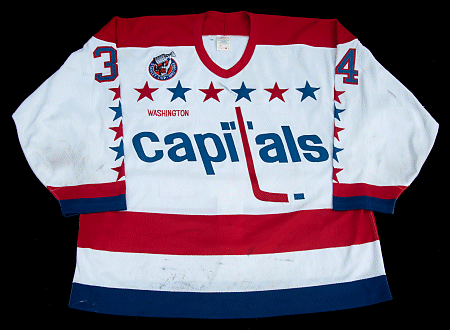
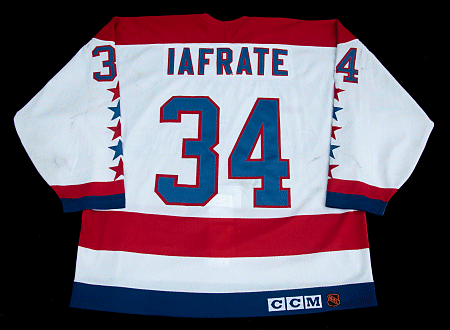
Kevin Hatcher's 34 goals in 1992-93 still stands as one of the greatest goal-scoring seasons of all time by a defenseman. Only three other defensemen have scored more - Bobby Orr, Paul Coffey and Doug Wilson. In fact, only one other defenseman has scored 30 goals since the 1992-93 season and that was another Capital - Mike Green in 2008-09.
The Pierre Turgeon Incident
Like most Capitals seasons of the 1980s and 90s, the 1992-93 season got off to a rocky start, then proceeded to climb steadily upwards with great hope and promise only to end in playoff defeat. While the 1992-93 season did end in a disappointing playoff defeat, one specific incident during the final game would ensure that Capitals fans would never forget this particular playoff series. Midway through the third period of the final game, Dale Hunter made an errant pass that was picked off by Pierre Turgeon and resulted in an Islanders goal and an insurmountable 5-1 Islander advantage. As Turgeon celebrated the goal well after the play was over, Hunter shoved him, knocking him off balance and into the boards. It immediately turned into a brawl on the ice and Hunter was ejected from the game. Turgeon suffered a separated shoulder and missed the next 6 playoff games.
Meanwhile, the NHL had been steadily cleaning up its image and removing the "goonery" that it felt had plagued it in the 1970s and 80s. Gary Bettman had been installed as the league's first Commissioner just 3 months prior and with the incident putting the NHL (not just Dale Hunter and the Capitals) in the media spotlight for yet another negative act, Bettman delivered the longest suspension ever for an on-ice incident - 21 games (one quarter of the 84 games) to start the 1993-94 season. It has been called the lowest point in Capitals history by some. Others think it has prevented Dale Hunter from getting into the Hall of Fame - he is still the only player with 1000+ points and 3000+ penalty minutes, was the first player to ever score two overtime, playoff series winning goals, and had 50+ points eleven times.
From an April 14, 2015 article in the Washington Post recalling the incident...
As [longtime Islander broadcaster Jiggs] McDonald tells it, “We leave to go to Pittsburgh for the next round.
Al Arbour (Islanders coach and eventual Hockey hall of famer) is sitting there at LaGuardia. And I sat down
beside Al, he seemed to be very pensive. I said, “Al, hypothetically, let’s say you got a call from the
commissioner, offering you the opportunity to replace Pierre Turgeon with one player off the Washington
Capitals roster. Without hesitation, he said, ‘Dale Hunter.'”
“I said, ‘What? He just took out your best player!”
“Yeah, he did,” Arbour replied.
“Why would you want him?” a stunned McDonald asked.
“Because he wants to win, he’ll do anything to win,” the coach deadpanned.

